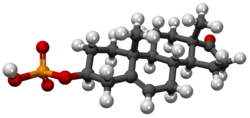DHEAS
 |
|
 |
|
| Names | |
|---|---|
|
IUPAC name
[(3S,8R,9S,10R,13S,14S)-10,13-Dimethyl-17-oxo-1,2,3,4,7,8,9,11,12,14,15,16-dodecahydrocyclopenta[a]phenanthren-3-yl] hydrogen sulfate
|
|
| Other names
Androstenolone sulfate; Prasterone sulfate; Androst-5-en-3β-ol-17-one 3β-sulfate
|
|
| Identifiers | |
|
3D model (JSmol)
|
|
| Abbreviations | DHEA sulfate; DHEA-S; DHEAS |
| ChemSpider | |
|
PubChem CID
|
|
|
|
|
|
| Properties | |
| C19H28O5S | |
| Molar mass | 368.49 g/mol |
|
Except where otherwise noted, data are given for materials in their standard state (at 25 °C [77 °F], 100 kPa).
|
|
|
|
|
| Infobox references | |
Dehydroepiandrosterone sulfate, abbreviated as DHEA sulfate or DHEA-S, also known as androstenolone sulfate, is an endogenous androstane steroid that is produced by the adrenal cortex. It is the 3β-sulfate ester and a metabolite of dehydroepiandrosterone (DHEA) that circulates in far greater relative concentrations. The steroid is hormonally inert and is instead an important neurosteroid and neurotrophin.
Similarly to other conjugated steroids, DHEA-S is devoid of hormonal activity, lacking affinity for the steroid hormone receptors. However, DHEA-S retains activity as a neurosteroid and neurotrophin. It has been found to act as a positive allosteric modulator of the NMDA receptor (50 nM–1 µM), negative allosteric modulator of the GABAA and glycine receptors, and weak agonist of the sigma-1 receptor (Kd > 50 µM). In addition, DHEA-S has been found to directly bind to and activate the TrkA and p75NTR – receptors of neurotrophins like nerve growth factor (NGF) and brain-derived neurotrophic factor (BDNF) – with high affinity (around 5 nM).
...
Wikipedia
